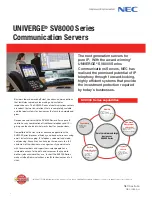
ASR 5000 Hardware Platform Overview
▀ Application Cards
▄ ASR 5000 Installation Guide
34
Packet Services Card (PSC)
The PSC has reached its end of life and is no longer available for purchase. It is not supported in StarOS Release 16.0+.
Packet Services Card Type A (PSCA)
The PSCA has reached its end of life and is no longer available for purchase. It is not supported in StarOS Release
16.0+.
Packet Services Card 2 (PSC2)
The PSC2 uses a fast network processor unit, featuring two quad-core x86 CPUs and 32 GB of RAM. These processors
run a single copy of the operating system. The operating system running on the PSC2 treats the two dual-core
processors as a 4-way multi-processor.
The PSC2 has a dedicated security processor that provides the highest performance for cryptographic acceleration of
next-generation IP Security (IPSec), Secure Sockets Layer (SSL) and wireless LAN/WAN security applications with the
latest security algorithms.
PSC2s should not be mixed with PSC3s. Due to the different processor speeds and memory configurations, the PSC2
cannot be combined in a chassis with other packet processing card types.
The PSC2 can dynamically adjust the line card connection mode to support switching between XGLCs and non-XGLCs
with minimal service interruption.
PSC2 is fully redundant with a spare PSC2.
Packet Services Card 3 (PSC3)
The PSC3 provides increased aggregate throughput and performance and a higher number of subscriber sessions than
the PSC2. Specialized hardware engines support parallel distributed processing for compression, classification, traffic
scheduling, forwarding, packet filtering, and statistics.
The PSC3 features two 6-core CPUs and 64 GB of RAM. These processors run a single copy of the operating system.
The operating system running on the PSC3 treats the two core processors as a 6-way multi-processor.
To optimize network efficiency and minimize down time, the system supports 1:n redundancy for PSC3s. If session
recovery is enabled, the minimum number of PSC3s per chassis increases from one to four cards. Three PSC3s are
active and one PSC3 is standby (redundant). This minimum configuration protects against software failures only. In
addition to increased hardware requirements, Session Recovery may reduce subscriber session capacity, performance,
and data throughput.
In the event of PSC3 failure, tasks are migrated from the active PSC3 to the standby card. The line card installed behind
the PSC3 that was formerly active maintains the interfaces to the external network equipment. Redundancy Crossbar
Cards (RCCs) provide a path for signaling and data traffic between the line card and the now active packet processing
card.
PSC3s must not be mixed with PSC2s.
The PSC3 is fully redundant with a spare PSC3.
Packet Processor Card (PPC) Description
The PSCA has reached its end of life and is no longer available for purchase. It is not supported in StarOS Release
16.0+.
Summary of Contents for ASR 5000 Series
Page 9: ...Contents ASR 5000 Installation Guide ix Spare Component Recommendations 317 ...
Page 10: ......
Page 14: ......
Page 54: ......
Page 64: ......
Page 90: ......
Page 104: ......
Page 122: ......
Page 126: ......
Page 186: ......
Page 194: ......
Page 206: ......
Page 228: ......
Page 276: ......
Page 284: ......
Page 290: ......
Page 300: ...RoHS Compliance Statement Chassis ASR 5000 Installation Guide 300 Chassis ...
Page 301: ...RoHS Compliance Statement Fan Assembly ASR 5000 Installation Guide 301 Fan Assembly ...
Page 303: ...RoHS Compliance Statement Full Product ASR 5000 Installation Guide 303 Full Product ...
Page 304: ...RoHS Compliance Statement Full Product ASR 5000 Installation Guide 304 ...
















































